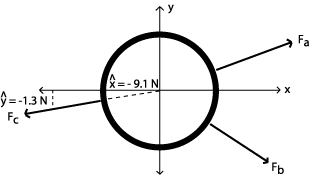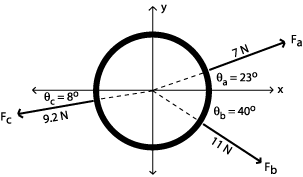|
|
|
|
| Solutions |
|
Part 1: Q1: A car is driving down the highway at 30 m/s. Out of a single thundercloud, a raindrop falls. The raindrop strikes the side window of the car moving directly downward at 40 m/s. It glancingly strikes the glass, skimming from one edge of the glass to the other. Ignore the effect of drag, gravity and surface tension. Sketch
this situation. Q2: What is the velocity (speed and angle) of the raindrop as it moves across the glass? Describe this mathematically and in your own words. We know the vertical and horizontal components of the triangle that is formed when the raindrop moves across the window. The vertical component is the velocity of the raindrop, 40 m/s. The horizontal component is the velocity of the car, 30 m/s. Employing the Pythagorean theorem, we can solve for the velocity of the raindrop's path across the window: c2 = a2 + b2 c2 = (30 m/s)2 + (40 m/s)2 c2 = 900 m2/s2 + 1600 m2/s2 = 2500 m2/s2 c = 50 m/s To find the angle of the path of the raindrop, we must employ a trigonometric function. To solve for q1, we can show: tan q1 = (30m/s)/(40m/s), therefore, q1 = tan-1 (30m/s)/(40m/s) = 36.9o To solve for q2, we can show: tan q2 = (40m/s)/(30m/s), therefore, q2 = tan-1 (40m/s)/(30m/s) = 53.1o Using this information, we can solve the problem by saying that the raindrop moves across the window at a velocity of 50 m/s, and an angle of 53.1o below the negative x-axis. Part 2: Q1: Determine the magnitude and direction of Fc such that the ring stays stationary. Ignore the force of gravity. If the ring is to remain stationary, then the sum of all the forces acting on the ring must be equal and opposite. To find a solution to this problem, we must break the forces down into their cartesian components. First, let's deal with Fa.
The force Fa has a magnitude of 7N in a direction 23o above the positive x-axis. To find the x and y components of this force, we must employ some trigonometric functions. First, to find the y component of Fa we can do as follows: sin 23o = y/7N, therefore, y = 7Nsin23o = 2.7N To find the x component of Fa, cos 23o = x/7N, therefore, x = 7Ncos23o = 6.4 N Now, let's find the x and y components of Fb:
The force Fb has a magnitude of 11N in a direction 40o below the positive x-axis. To find the x and y components of this force, we must employ some trigonometric functions. First, to find the y component of Fb we can do as follows: sin 40o = y/11N, therefore, y = 11Nsin40o = -7.1 N To find the x component of Fb, cos 40o = x/11N, therefore, x = 11Ncos40o = 8.4 N Once again, if the ring is to remain stationary, then the sum of all the forces acting on the ring must be equal and opposite. Now we must total the component forces of Fa and Fb. The magnitude of Fc must be equal and opposite to te sum of Fa anf Fb: Fa: 6.4 N x +
2.7 N y Fa + Fb = 6.4 Nx + 2.7 N x + 8.4 Ny - 7.1 N y = 9.1 N x + 1.3 N y We now know that Fc must have the components: - (9.1 N x + 1.3 N y) = -9.1 N X - 1.3 N y Using the component information about Fc, we can determine the magnitude of Fc and it's direction:
First, to solve for the magnitude of Fc, we can employ the Pythagorean Theorem as follows: c2 = a2 + b2 c2 = (-9.1)2 + (-1.3)2 c2 = 84.5 c = 9.2 So, the magnitude of Fc is 9.2N To find the direction of the force Fc, we must employ some more trigonometry: tan q = -1.3/-9.1 = 0.14 q = tan-1 (0.14) = 8o Now we know that the force Fc has a magnitude of 9.2N in a direction 8o below the negative x-axis. Q2: Sketch all three forces and describe them in your own words.
The force Fa has a magnitude of 7N in a direction 23o above the positive x-axis. The force Fb has a magnitude of 11N in a direction 40o below the positive x-axis. The force Fc has a magnitude of 9.2N in a direction 8o below the negative x-axis. The ring stays stationary because the sum of all three forces is zero. |
|
|
|
|




